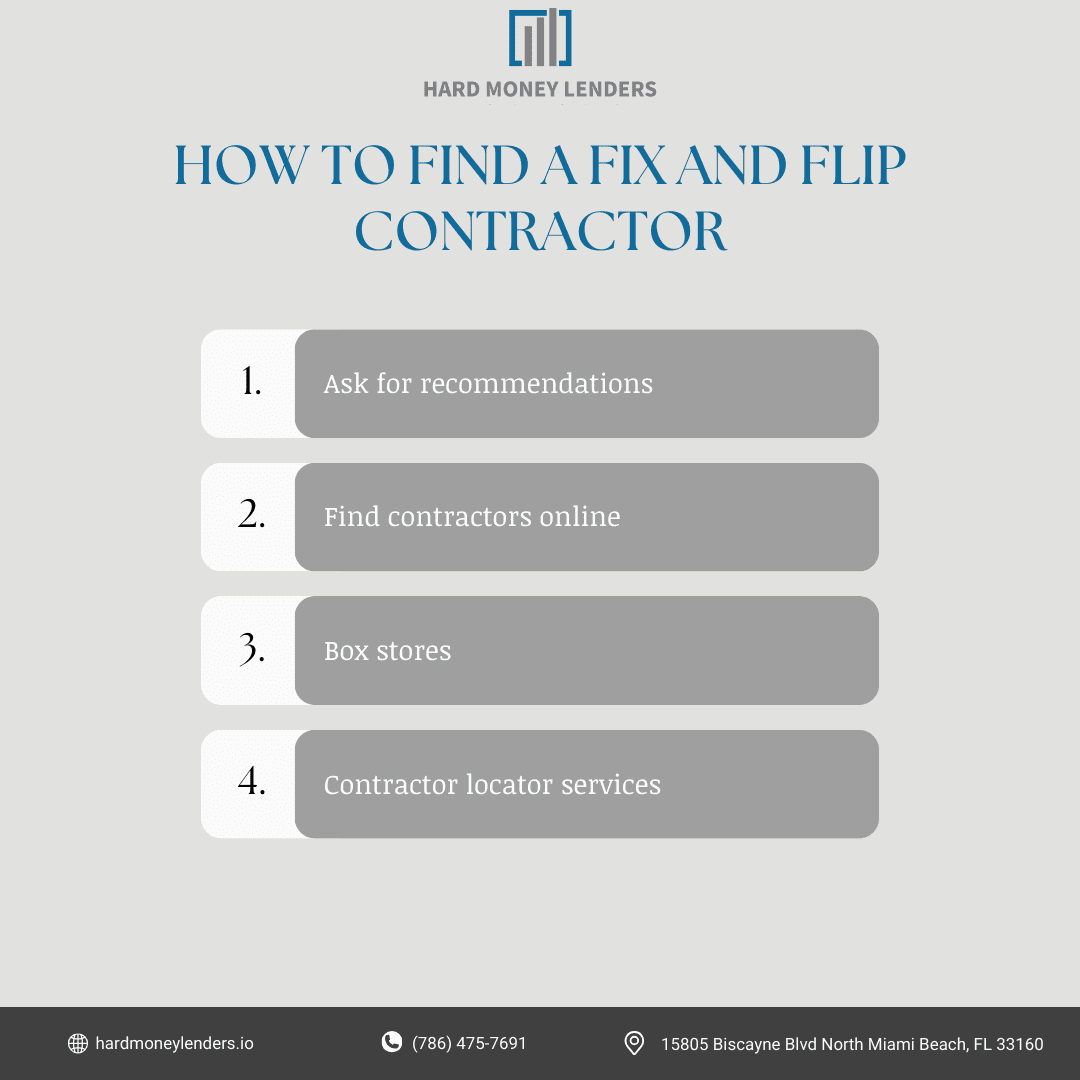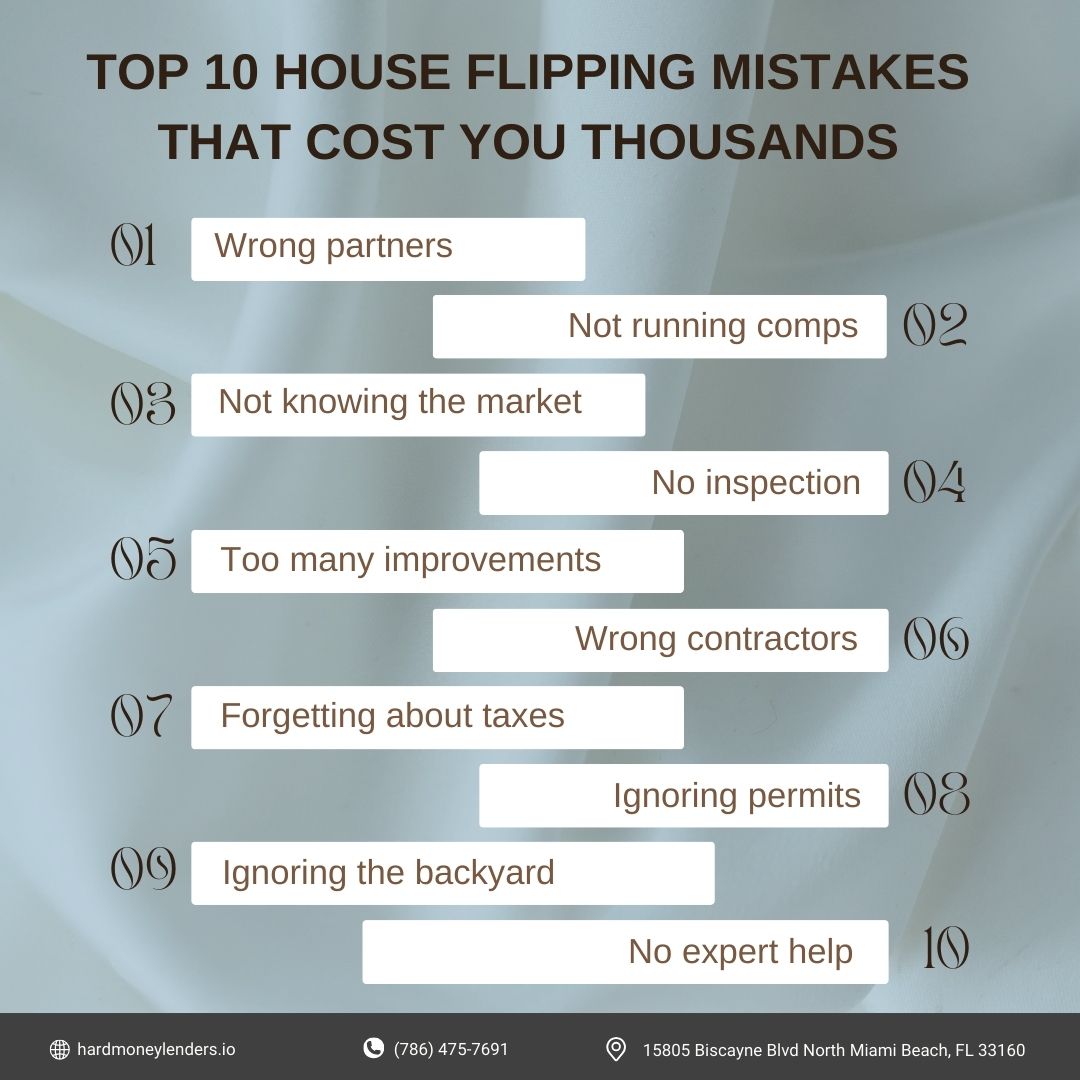Last Updated on May 27, 2024
House flipping can be an extremely lucrative business for many real estate investors. If you play your cards right, with enough patience and practice, you may be able to turn your house-flipping side hustle into a full-time career. However, many beginner house flippers encounter a few mistakes when they first start off. Here are the top ten mistakes that are commonly made by house flippers and how to avoid them.
Mistake #1 – Partnering with the Wrong People
Many house flippers will partner with another investor when flipping houses. In many cases, one investor will provide the money and another investor will find the deals and do most of the work. Partnering can work out great in real estate if everyone’s job is clear and it is all in writing. I see other real estate investors partnering on flips because they want to share the risk.
They do not have a clear job description for what each partner is responsible for or a clear definition of who pays what and when. Many times the partners have different ideas of what hard work is or how much time should be spent on the project. When problems come up, there is no clear solution on how one partner can exit the deal.
It is usually not smart to partner on a deal, just to feel safer and share risk. The best partnerships are when the partners have clearly defined roles that bring different skills to the project.
Pro Tip
Establish a thorough vetting process that includes reviewing potential partners’ past project portfolios and checking financial backgrounds. Draft a comprehensive partnership agreement with the help of a real estate attorney. This contract should include detailed roles, responsibilities, financial contributions, profit sharing, and procedures for resolving conflicts and exiting the partnership.
Regularly scheduled reviews should be held to ensure alignment on project goals and financial commitments. This approach minimizes misunderstandings and ensures a professional working relationship. Engaging a mediator for conflict resolution can also be a proactive step.
Mistake #2 – Not Running Good Comps Before Buying
After the investment property is bought and the renovations are complete is not the time to run comps for the first time. You’ll definitely want to run the comps before listing the home, but you should also do that before buying. It’s the only way to accurately guesstimate what kind of gross return you can expect after the acquisition, renovation, and listing costs.
In addition to looking at the recent sales in the area, your research should also take a look at how current prices compare to the last peak. This will give you an idea of whether prices are still on the upswing and by how much.
Pro Tip
Employ advanced tools and resources for market analysis. Services like CoreLogic or local MLS provide in-depth market data that can be invaluable. Additionally, engage with a seasoned real estate agent or appraiser who specializes in the investment property’s area to understand the nuances of local market trends.
This professional should help interpret data regarding how long properties stay on the market, which renovations are most profitable, and how much buyers are willing to pay for specific upgrades. This information is crucial to making informed purchasing decisions and setting realistic budgets for property renovations.
Mistake #3 – Not Knowing What Local Home Buyers Want
You can spend thousands renovating a home in a style that you find to be ideal only to discover that it’s not what buyers like. House flippers have to know their target audience and have a finger on the pulse of their local market. They should know what types of home styles have appeal, the finishes that are most popular and which upgrades will attract buyers.
When in doubt, always go neutral. It’s better to have a home that’s a relatively clean canvas for the buyer to make their own than to turn people off with a distinctly stylized decor.
Pro Tip
Beyond basic market research, implement a strategy that includes attending local real estate events, community forums, and seminars to gather direct feedback from potential buyers and other investors. Utilize online surveys targeted at the local community to understand buyer preferences in real time.
Stay updated with publications from real estate associations like the National Association of Realtors, which often publish trend reports and consumer surveys. Tailor property renovations to these preferences to ensure the property appeals to the broadest market possible while focusing on high-return investments.
Mistake #4 – Forgoing the Inspection
Even in distressed sale situations, you usually have an opportunity to do a home inspection. It’s a key part of doing your due diligence. Even if you can’t get inside the home, an inspector can still take a look at the outside to search for signs of structural, roofing, electrical, and foundation issues. You may even be able to tell if there’s water damage from the outside.
Pro Tip
Engage with multiple specialized inspectors to evaluate different aspects of the property, such as structural integrity, plumbing, electrical systems, and potential pest issues. Consider environmental assessments for older properties that might contain hazardous materials like asbestos or lead.
Use the detailed reports from these inspections to negotiate repair credits with the seller or to adjust the purchase offer. Regular updates from the inspector during the renovation process can also ensure that all modifications meet local codes and quality standards, thereby avoiding costly corrections after project completion.
Mistake #5 – Over-improving the Property
Over-improving essentially means going overboard with improvements and/or using materials and finishes that are more upscale than they need to be. In some high-end markets and neighborhoods, it’s virtually impossible to over-improve a property. However, in most cases making a flip better than any other home on the block doesn’t have the biggest return.
The best strategy is to make the home comparable to other top-selling homes in the neighborhood. Using quality materials is always a good idea, but there’s no need to install radiant flooring, a saltwater pool and marble showers in a neighborhood with $250,000 homes.
Pro Tip
Develop a renovation plan that aligns with current market demands and typical buyer expectations in the neighborhood. Consult with interior designers or architects who have experience in maximizing space and choosing cost-effective materials that provide durability and aesthetic appeal.
Benchmarking against recently sold properties in the same area can guide your decisions on which improvements will offer the best return on investment. Investments should be made with an understanding of the typical ROI for each type of renovation in your specific market, which can be obtained from trusted real estate investment resources or local market studies.
Mistake #6 – Hiring the Wrong Contractor
One of the biggest challenges of running a flipping business is hiring the right contractors and keeping them working. It is tough to find decent contractors and when you do find decent ones, many times they don’t stay decent. They will raise prices, take on too many jobs, hire the wrong people, or get tired of the business. We have to keep tabs on our contractors as well to make sure they are working fast and within budget. If we don’t check on a house or a contractor for a week or two, I can almost guarantee they aren’t doing what they are supposed to be doing. We are in constant contact with our contractors and always looking for more as well.

Be sure to check out our “Beginner’s Guide to Finding a Fix and Flip Contractor”.
Pro Tip
Develop a robust screening process by requesting and verifying the contractor’s state licensing and proof of insurance to ensure credibility. Ask for an extensive list of references and recent project photos to assess the quality and relevance of their previous work.
Draft a comprehensive contract that outlines project specifications, payment terms (including a clear clause on retainers), timelines, and conditions for contract termination. Regularly scheduled site visits and meetings should be implemented to review project progress, which helps maintain contractor accountability and adherence to timelines. Utilize construction management software to track progress and maintain communication.
Mistake #7 – Forgetting About Taxes
Purchase price and renovation costs are the major expenses of a flip, but there’s another line item people often forget to factor into their break-even calculations. Taxes are an inevitable expense that will eat into your net return. When you turn a profit you’ll have to pay short-term capital gains taxes. Transfer taxes and property taxes will also need to be paid.
Pro Tip
Early in the flipping process, engage with a certified public accountant (CPA) or a tax advisor who specializes in real estate investments.
This professional can provide a detailed overview of tax obligations, potential deductions (such as renovation costs, interest on loans, and property taxes), and strategies for minimizing tax liabilities associated with short-term capital gains. Structured tax planning should be used to project net profits accurately and to strategically time the sale of the property to optimize tax benefits.
Mistake #8 – Ignoring Zoning and Permits
So many flippers are tempted to bypass the permitting process and disregard zoning regulations. They are a hindrance, but ignoring them could be a costly mistake. If the city finds out work is being done without permits you could face serious fines and have to undo all the renovations that have already been completed. You could also find yourself entangled in a lawsuit or tough negotiations if the buyers find defects and unpermitted projects.
Pro Tip
Prior to acquisition, conduct a thorough review of local zoning ordinances and building codes by consulting with a planning officer or a specialized real estate attorney. This should include understanding limitations and requirements that could affect your renovation plans.
Secure all necessary permits before commencing any work; this ensures legal compliance and avoids potential fines. Regularly consult with the local building inspector throughout the renovation process to ensure ongoing compliance with all building standards and regulations.
Mistake #9 – Ignoring the Backyard
Curb appeal and outdoor living are huge selling points. Most flippers budget for improving the front of the house, but then they completely ignore the backyard. It’s a big let down for buyers that tour a beautifully renovated home only to find the backyard needs a lot of work.
Even if the renovation budget is tight, a recent outdoor features a survey from the National Association of Realtors (NAR) that shows that new sod, lawn care, and landscaping are a great investment. These improvements have high ROI and will get you a dollar for dollar return while helping the home sell quicker. Fire features and wood decks also rate high on the home buyer wish list.
There’s another added benefit to outdoor improvements. If the home is small a deck or patio is a low-cost way of expanding the living space.
Pro Tip
Research shows that well-landscaped homes have a significant price advantage over homes with minimal landscaping. Develop a landscape plan that includes features most valued in your market, such as decks, patios, and fire pits.
Consider low-maintenance but high-impact designs that utilize native plants and offer seasonal interest. Budgeting for professional landscape design and installation can lead to a higher return on investment by enhancing curb appeal and making the property stand out in competitive markets.
Mistake #10 – Not Enlisting the Help of a Real Estate Agent
Flippers that don’t have a real estate license really need to find a real estate agent with experience in the local market. They provide so many valuable services, some of which are free.
When you’re on the buying end a real estate agent is paid by the seller. All of their guidance and assistance won’t cost a penny. They’ll shoulder a lot of the responsibilities and can provide expert advice on whether a home is a good investment.
After the sale is complete, a real estate agent can provide insight into what local home buyers are looking for and pass along their industry contacts. When it comes time to sell, your agent can pull the comparables and help you determine the best list price.
Worried about the cost of paying commission? Research has shown using a real estate agent for a house flip isn’t more expensive. Homes sold by agents typically sell for 6% more than FSBOs, which covers the cost of the commission and they’ll handle the marketing expenses. The agent may even be willing to accept a lower commission rate if they helped you purchase the property or get a guarantee to help you with future flips.
Pro Tip
Partner with a real estate agent who not only specializes in the local market but also has experience with flipped properties. Such agents bring a wealth of knowledge regarding optimal pricing strategies, effective marketing techniques, and buyer preferences.
They can leverage their network to expedite sales and handle complex negotiations. Discussing the possibility of reduced commissions in exchange for repeat business can be beneficial when planning multiple flips. Regular updates and strategy sessions with your agent can help adjust the marketing approach as needed to ensure a quick and profitable sale.
Conclusion
If you’re just starting out in the house flipping industry, these are ten common mistakes that you generally want to avoid. Before jumping into house flipping make sure you’re fully aware of the commitment it takes and the risks that are involved. Many beginners underestimate the time, money, and effort it takes to successfully flip a house, while others overestimate their knowledge and skills. House flipping is not as easy as it seems, so be sure to put in the time and effort to properly research your business endeavor before diving in head first.
FAQs
What is the hardest part of flipping a house?
The most difficult aspect of flipping a house often revolves around managing renovations efficiently while staying on budget. Unexpected costs are frequent when hidden damages such as foundational issues, plumbing problems, or electrical system failures are uncovered during renovations. This can drastically increase expenditure and delay timelines. Effective risk management includes conducting a thorough pre-purchase inspection by a qualified professional, budgeting for a contingency fund of at least 20% of the project’s total cost, and regularly revisiting and adjusting the budget and timeline throughout the renovation process.
How long should it take to flip a house?
The timeline for flipping a house generally ranges from 4 to 12 months. This timeframe includes the initial property acquisition, the time needed to complete renovations, and the sale of the property. Quick flips, focusing on cosmetic upgrades, can be completed in a shorter period, whereas extensive remodels might take longer. To optimize efficiency, develop a detailed project timeline with your contractor and adhere strictly to it, and always prepare for potential delays by having backup plans for critical tasks.
Should you avoid buying a flipped house?
While flipped houses can be excellent purchases, caution is necessary. Potential buyers should scrutinize the quality of the renovations. Detailed checks should include ensuring that significant systems (like plumbing and electrical) have been updated and are up to code, and that cosmetic improvements were not made to mask deeper problems. Hiring an independent home inspector to examine the flipped house can provide an unbiased report on both the visible and underlying condition of the property. Additionally, understanding the flipper’s reputation and the property’s history can provide further assurance.
Do house flippers pay taxes?
Profits from house flipping are subject to taxation, and how they are taxed can vary based on how long the property was held and whether the IRS considers your activities as a business. If the property was owned for less than a year, profits are typically taxed as short-term capital gains, which are taxed at the individual’s income tax rate. For those who flip houses regularly, this activity might be considered a business, making profits subject to self-employment taxes as well. To manage potential tax liabilities effectively, consult with a tax advisor who specializes in real estate investing to explore all possible tax deductions and strategies.
How to start flipping houses for beginners?
Beginners should start by educating themselves thoroughly about the real estate market and financial management required for flipping houses. This can be done through real estate courses, mentorship programs, and reading up-to-date material on property investment. It’s crucial to understand the local real estate market conditions, identify what properties are in demand, and learn to accurately calculate renovation costs and potential ROI. Beginners should also network with experienced real estate professionals, including agents, contractors, and other flippers. Initial investments should be conservative, possibly starting with properties that require minor cosmetic fixes to limit risk. Lastly, securing adequate financing and having a detailed business plan in place are imperative steps before undertaking your first flip.

Jack Roberts has spent the last 5 years in the Private Money Lending world helping real estate investors secure financing for their non-owner occupied real estate investments. When he’s not thinking about real estate, Adam is an avid Jazz music fan and fisherman.



